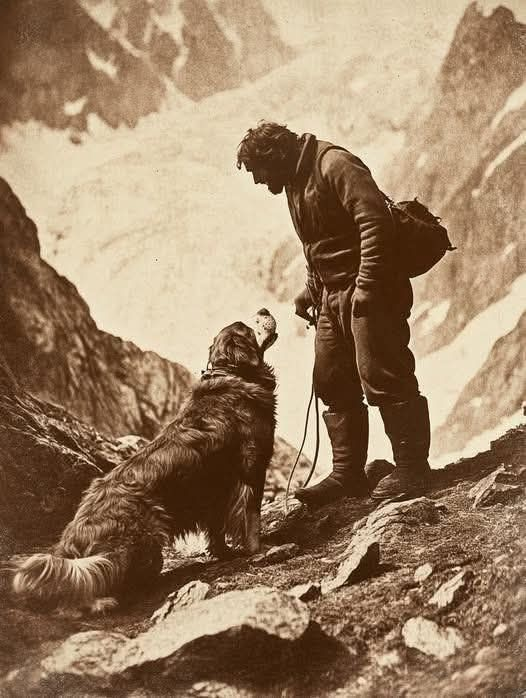Barry the Alpine Guardian: Legend, Fact, and Legacy
In the silent white vastness of the Swiss Alps, where wind and snow reign and paths vanish in blizzards, a legend was born. His name: Barry — a dog whose story of rescue, loyalty, and myth has echoed across centuries. What began as whispered tales in mountain hospices grew into a symbol of hope for those confronted by nature’s fiercest conditions.
A Humble Beginning in the High Pass
Barry was born around the year 1800, not far from the Great St. Bernard Pass — a rugged, treacherous route connecting Switzerland with Italy. At that time, the Great St. Bernard Hospice sat perched high in the snow-laced Alps, maintained by Augustinian canons and monks who had long committed themselves to helping travelers. Over centuries, they served as beacons of refuge for pilgrims, wanderers, and those who lost their way in storms.
To assist in locating stranded travelers and guiding them back to safety, the monks gradually recruited dogs, often local mongrels or working mountain breeds, familiar with the terrain, snow, and weather. These dogs weren’t the giant, barrel-wearing St. Bernards popular in later imagery — they were leaner, more nimble, with acute senses suited to the alpine environment.

Barry entered this world of service. From an early age, he would accompany monks and guides on patrols, learning snow paths, scents, and the signs of distress in the mountains. Over time he matured into one of the hospice’s most trusted companions, suited by nature and training for high-stakes rescue missions.
More Than a Dog — A Rescuer Among the Storms
Barry’s fame rests upon the claim that, during his lifetime, he rescued around 40 people — travelers lost to snow, collapse, disorientation, or avalanches. Though exact records are sparse and some accounts embellished, the repeated telling of these stories reveals a consensus about his exceptional bravery.
One of the most enduring tales involves a boy found in an ice crevasse, freezing and unconscious. According to legend, Barry discovered him, licked him to bring warmth, then gently coaxed him onto his own back and carried him to safety. While this image — dog carrying human — has the drama of myth, it captures the spirit of what Barry came to represent: guardian, guide, savior.
Barry’s role was not limited to direct rescue. In many cases, his acute sense of direction and smell enabled him to lead rescuers toward those stranded, or alert the monks to possible locations of victims. In heavy snow or fog, while human guides might lose their bearings, Barry’s instinct and training often guided the path.
It’s critical to note: some stories around him have been exaggerated over time. For instance, the idea of him carrying a small barrel of brandy to revive victims is likely myth rather than fact. The dramatic notion of Barry being killed by a soldier who mistook him for a wolf is likewise probably invented; historical evidence suggests he died of natural causes after retirement.
The Final Years and Posthumous Fame
In the later years of his life, Barry’s strength waned. When he could no longer serve regularly in the mountains, the hospice prior arranged for him to retire in the city of Bern, in the Swiss lowlands. He spent his final years in relative calm, away from the freezing peaks.
Barry passed away in 1814. But death did not silence his presence. His body was preserved — taxidermied — and placed in the Natural History Museum in Bern, where for many years he was on public display. However, even the preserved Barry underwent changes: in 1923, restorers reworked his pose and even altered his skull shape slightly to resemble the more modern, stockier St. Bernard image becoming popular at that time. His original coat, though, remains.
Over time, his display evolved into a full exhibition that explores both his life and the legends around him. In that exhibition, museum curators and historians carefully distinguish myth from fact, prompting visitors to ask: how much of what we believe is reality — and how much has been shaped by storytelling?
The Enduring Legacy
Barry is sometimes called “Barry der Menschenretter” — Barry the People Rescuer — a name that underscores his symbolic place in Alpine folklore. Even long after his death, the hospice tradition continued: each generation of hospice dogs includes at least one named “Barry” in his honor. In 2004, the responsibility for breeding and caring for these dogs was transferred to the Barry Foundation in Martigny, which now also maintains a museum and breeding facility.
Though modern mountain rescue relies heavily on helicopters, avalanche dogs, GPS, and high-tech gear, Barry’s story remains a powerful reminder of the bond between humans and animals, and the ways in which nature, faith, and courage intersect.
In the stillness of snow-blown highlands, where paths vanish and life depends on small gestures, Barry’s legacy lives on — a silent sentinel, a legend, and an inspiration.